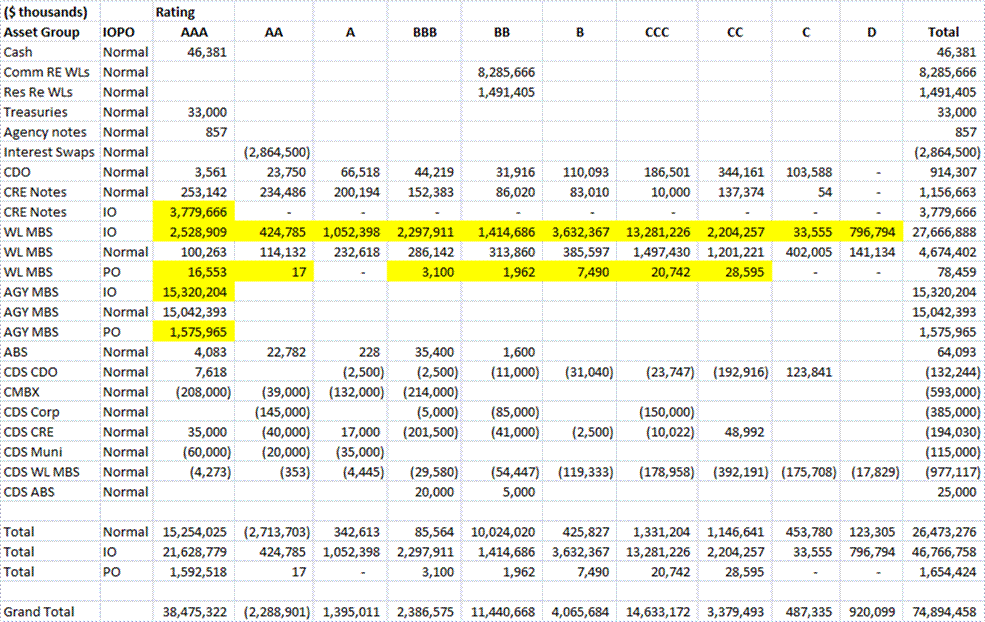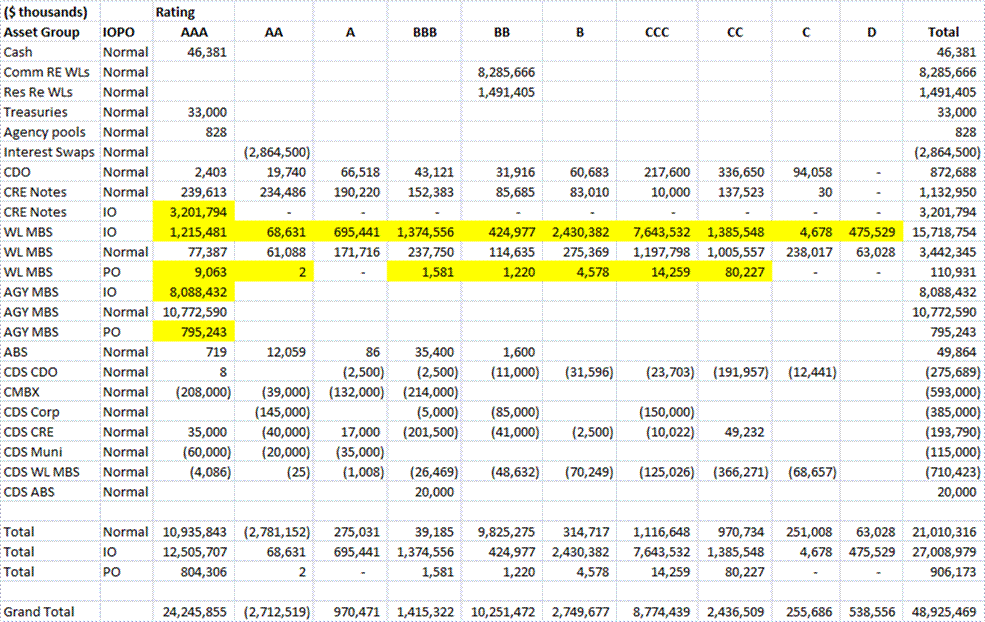Prepayment and default are dual to each other.? The less likely is default, the more likely is prepayment, and vice-versa.
In a pool of loans, the critical distinction is the likelihood of loans to prepay or default.? Just because prepayment has been high, does not mean the remainder won?t default under stress.
I don’t have clear answers to Maiden Lane LLC, the bailout of Bear Stearns yet.? The complexity of Maiden Lane LLC, as compared to Maiden Lane 2 or 3, is enormous.? I have a more work to do.? But, at least, I have scrubbed the data, and figured our what the Fed released to us.
In the Bear Stearns bailout, the Fed received a wide variety of securities, including:
| Cash |
| CDOs |
| Comm RE WLs |
| CRE Notes |
| Agency pools |
| Agency MBS |
| WL MBS |
| ABS |
| Res Re WLs |
| Treasuries |
| CDS CDOs |
| CMBX |
| CDS Corporate |
| CDS CRE Securities |
| CDS Municipal |
| CDS WL MBS |
| CDS ABS |
| Interest Swaps |
Maiden Lane 2 & 3 were simple compared to this, and this had over 10x the securities of both combined. Plus, this had CDS transactions which would profit from failure of a wide variety of assets.
Additional difficulties included a lot of coding difficulties on the CDS.? The Fed did not try to make things clear.? I spent many hours trying to clarify the tranches in question.? A few of them are guesses, but 99% are reliable.
The Fed’s principal figures were original principal figures not those for current principal.? That was another area of ambiguity.
After all that, here is my breakdown of?the assets by original principal:

And, here is my breakdown of the assets by current principal:

–
The current value of what is owed to the Fed is over $28 billion.? There is almost $49 billion in current principal, so why worry?
Worry because of all of the interest only securities.? The principal for them is notional; principal payments will never be made.? With CMBS, I know that IO securities are typically worth no more than 5% of the notional principal balance.? Because most CMBS protect against prepayment, the prices of interest only securities reflect? the likelihood of default.? Though they are rated AAA, their creditworthiness is more like BB.
With Residential mortgages, the question is harder.? How big is the interest margin, and when might it cut off due to default or prepayment?? Interest only securities are typically worth a lot less then the? notional principal.? Same for principal only securities.? Their value is the likelihood of payment discounted by the length of time until payment.
Beyond that, there are the residential and commercial loans made, with almost $10 billion of principal, for which we have no idea of the creditworthiness.? Are there any statistics on the currency of the collateral?? The Fed had not deigned to tell us.? I place the creditworthiness at BB, but who knows for sure?
I can tell you now that the securities involved were mostly originated 2005-2007, during the worst of the underwriting cycle.? Is it any surprise?? Few can escape the credit cycle.? Within a given credit cycle, the credit quality of securities originated declines all of the way till slightly past the peak of the credit cycle.
I am going to do more analysis of the RMBS, so that I can get a better feel for the value there.? It is not clear to me whether Maiden Lane LLC is adequately funded or not.? The high degree of junk, whole loans, and interest only securities gives me doubt.

Please post a brief on how plain 30yr fixed rate GNMA work.
What happens when the GNMA pool is mostly paid off (maybe 75% principle paid off)?
Does it get stuck with a set of very unlikely to be paid of early loans that pay almost all principal (i.e., you get no return on your original investment)?
Is there are real secondary market for those almost paid off GNMA securities, or would an investor be stuck with a zero coupon like bond that can only be sold at a significant discount to face (e.g. remaining principal doscounted to yield about 4% a year for X years)?
Please explain the “Income Factor”, “Expense Factor” and “MDF” in the GNMA tax and factor data.
“The current value of what is owed to the Fed is over $28 billion. There is almost $49 billion in current principal, so why worry?”
Just for us neophytes in the audience, this is the collateral the Fed got for the loan they gave JPMorgan to buy Bear Stearns? And really, it’s more like the Fed just bought these assets outright from JPMorgan for $28 billion (plus the 2.5% interest rate – which I guess is annual?) because it’s not like JPMorgan is actually going to pay them back that $28 billion. The Fed will just be stuck with this stuff?
Thanks for taking the time to dig through the Fed release. Really great stuff.